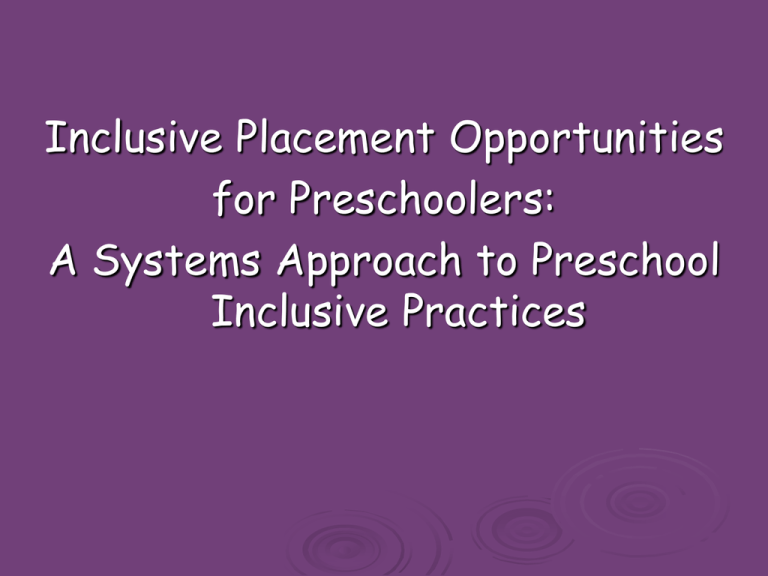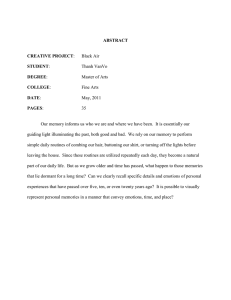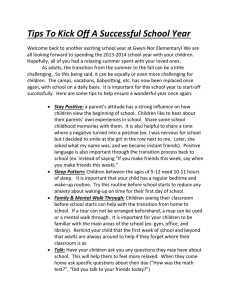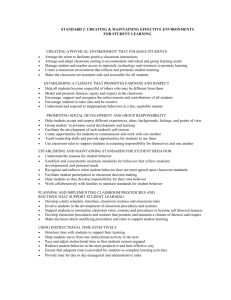Inclusive Placement Opportunities for Preschoolers: A Systems Approach to Preschool Inclusive Practices
advertisement

Inclusive Placement Opportunities for Preschoolers: A Systems Approach to Preschool Inclusive Practices A project of the Virginia Department of Education and the Training and Technical Assistance Centers of Virginia Routines-based assessment Agenda • • • • Why conduct routines-based assessments? Steps in routines-based assessments o Assessing within classroom routines How to prepare How to conduct o Routines-based interview with family How to prepare How to conduct How to analyze assessment results and identify functional goals to teach Amend children’s IEPs (if applicable) What is Routine-Based Assessment? Activity Why use a routines-based assessment? Use routines-based assessment because … • Ongoing assessments in their natural routines is a recommended practice • It allows teachers to see a complete picture of a child if assessments are conducted related to home and school routines • RBA ensures that what is identified to teach is relevant and worth learning Setting the stage • Assess the classroom • Early Childhood Environment Rating Scale-Revised (ECERSR) • Quality Classroom Assessment Gathering information for an individual child • Prepare for assessments o Develop and select tools to use to gather information about each child within the classroom Observation Potential objectives • Develop routines-based assessment plans • Make individual portfolios RBA for each child • Who will do the observational assessment(s)? • What type(s) of assessment(s) will be done? • How and when will assessment results be shared? Prepare for the school observation • Who will be observed? o • What will be observed? o • Gertrude and Jaun Physical (fine and gross motor), social-emotional and cognitive skills What routines and activities will the child's performance be observed in? o Arrival, circle, centers, snack, story, outdoor play, lunch and dismissal Prepare for the school observation • Time period/routines and activities o 8:30-8:45 – Circle o Beginning: Sit on a rug in circle o o Middle: Sing, discuss theme, review calendar and choose jobs End: Choose and go to a center Individual portfolios • When using portfolios consider: o 3-ring notebooks o Accordion folders o Pizza boxes o Poster boards and brads o Child-made portfolio Five areas of a portfolio 1) Record of progress 2) Initial assessment results 3) Program goals and objectives 4) Areas of development 5) Correspondence with the family Let's practice Assessments in routines from teachers • Determine levels of engagement in classroom routines • Scale for the Assessment of Teachers’ Impressions of Routines and Engagement (STARE) o Provides a framework for interviewing teachers about how the focal child functions during daily classroom routines. Scale for Teachers’ Assessment of Routines Engagement R.A. McWilliam Frank Porter Graham Child Development Center University of North Carolina at Chapel Hill ©2000 Directions: Observe the child for 10 minutes in each of the following routines. First, rate the amount of time the child is engaged with adults, peers and materials. Second, rate the complexity of the child's engagement. There is space to add additional or alternate routines at the end of the scale. Arrival Almost none of the time Little of the time Half of the time Much of the time Almost all of the time With adults 1 2 3 4 5 With peers 1 2 3 4 5 With materials 1 2 3 4 5 Complexity Nonengaged 1 Unsophisticated 2 Average 3 Advanced 4 Sophisticated 5 Involving families in the process How do we involve families: functional intervention planning • Need a structure for families to have a meaningful role in planning • Need to emphasize that intervention is family-centered • Need a list of functional outcomes • Need a method for jumpstarting a positive relationship with families McWilliam 2004 Answer to needs: routine-based interview • Interview o Family on home routines o Teacher on classroom routines Useful scale for the RBI • Scale for Assessment of Family Enjoyment within Routines (SAFER) o Provides a framework for gathering information from the family about home and community routines Who conducts the RBI? • Classroom teacher • Director of center or program • Specialists Note: Any member of the child’s team who is involved with assessment and intervention planning can do the RBI. Steps in routines-based assessment • Conduct routines-based assessments o o o Interview each child’s family Conduct school observation and compare to checklist of potential objectives for each child File school observation and family interview results in each child’s portfolio RBI pointers • Two people plus the family during the RBI is ideal • Keep the interviews conversational Interviewing skills • Relax – do not ask a checklist of questions • Show real interest – do not make it look perfunctory • Empathize – do not be poker-faced • Accept – do not judge • Use your strengths – do not assume everyone has or should have the same style Preparation for the routine-based interview • Divorce eligibility evaluations from intervention planning; once eligible for services, use the routine-based interview process for planning interventions • Prepare families to report on routines • Prepare classroom staff to report on routines Routines in the home • Times of the day o o Families wake up, eat, hang out and go places Teachers have daily activities or events in their classrooms, usually reflected on the classroom schedule, such as centers, circle and snack Preparing families for the RBI • Inform them that you are interested in learning about their priorities for their child • Inform them that a way to learn about their priorities is to hear about what daily life is like for them and what routines are in place • Provide forms to them if they desire a structured approach for preparing Family-centered practices • When planning for the RBI, ask families their preferences for: o Who will be there o What will happen o Where it will take place o When it will take place Six steps to the RBI 1. Prepare the family to report on routines 2. Family reports on their routines 3. Teacher reports on classroom routines 4. Interviewer reviews concern and strength areas 5. Family and teacher select outcomes 6. Family and teacher put outcomes into priority order Step 1: Prepare for the family interview • Family routines • Relating with others • Family and community activities Let’s observe an interview Step 2: Family reports on their routines • Begin with the start of the family’s day • For each routine, six questions are answered: o What does everyone do at this time? o What does the child do? o How does the child participate (engagement)? o o o What does the child do by him or herself (independence)? How does the child communicate and get along with others (social relationships)? How satisfied is the family with the routine? Looking at family routines Step 3: Teacher reports on classroom routines • Teacher shares information • Family and teacher discuss information Step 4: Interviewer reviews concern and strength areas • Refresh family’s memory • Recap concerns with the family • Show them the starred items Interview wrap up Step 5: Family and teacher select outcomes • Outcomes are the potential problem areas identified during the interview • Keep wording of outcomes the same as the family’s • Six to 10 outcomes are typically generated • Be prepared to remind the family of concern areas described during interview but not mentioned at this step Step 6: Family and teacher put outcomes into priority order • Show list of outcomes to family • Ask them to put them in order of importance • From this point forward, the outcomes will always be listed in priority order RBI review • Go through each routine with family • Get a sense of family and child functioning • Write down significant information • Star concerns • Recap concerns with family, showing them the starred items RBI review (cont’d) • Ask the family what they would like to concentrate on • Write down these outcomes • Ask them for the priority order of outcomes • Begin to develop functional goals based on family and teacher priorities Hallmark feature of the RBI • The RBI leads directly to objectives that are: o Functional o Meaningful o Consistent across environments Functionality test When reading a goal … the answer to “Why is the child working on this goal?” should be immediately apparent within the goal itself How to write functional goals Five guiding principles: 1. Make outcome statements meaningful 2. Objectives and strategies should make use of existing attributes 3. Evaluate outcomes meaningfully 4. Encourage all to have an investment in outcomes 5. Functionality guides writing Guiding principles in action • • • • • Meaningful o Kim will hang up her jacket on the hook with her name Make use of existing attributes o Kim likes to see her name in writing Evaluate outcomes meaningfully o Kim will hang up her jacket once a day Everyone is invested o Kim’s family will use a hook at home for jackets Functionality o Kim is currently dropping her jacket on the floor in a hurry, becoming upset when asked to return from free play to hang it up When writing goals … • • Remember the three child behaviors of o Engagement o Independence o Social relationships Remember that goals do not belong to domains Engagement An engaged child • Shows attention in participation • Demonstrates goal-directed behavior Independence Independence enables a child to • Access materials • Move about within the environment • Interact with others • Develop feelings of competence • Have a sense of accomplishment Social relationships • Interaction with adults and peers • Children with developmental disabilities often have difficulty developing peer-related social competence Let’s practice • 3-year-old with developmental delays o o o o Student will stack blocks to form a tower 3 out of 4 trials over a week Student will walk up and down three steps when in physical therapy Student will use a spoon to eat applesauce during the daily lunch Student will share toys with others during center time Identify objectives to teach • While playing, Jaun will: o o o Build complex structures with building materials (e.g., using blocks to make bridges) Complete interlocking toys (e.g., puzzles with up to six pieces, Lincoln logs, Legos) Have daily experiences with concepts of literacy, works and letters (e.g., by pretending to read books, having books read to him, having words and their meanings described, seeing words that label familiar objects, writing pretend letters, writing own name, writing in own journal) Identify objectives to teach • To participate more in daily routines, Gertrude will: o Use a jelly bean switch while playing to: Activate age-appropriate computer programs and table toys with peers while sitting in a vac pac secured to a child-size chair Play a tape recorded clean-up song, circle song or story on tape, while lying over a bolster or sitting in a corner chair Identify objectives to teach (cont’d) • To participate more in daily routines, Gertrude will: o Play by reaching, grasping (using fingers against palms) and using: Sand and water toys and cooking items with peers with adult support to stand while wearing knee stabilizers Stuffed animals with peers Revise the IEP • Amend children’s IEPs (if applicable) o Reconvene IEP teams o Amend IEPs with newly identified objectives Thoughts/Questions/Comments ?



